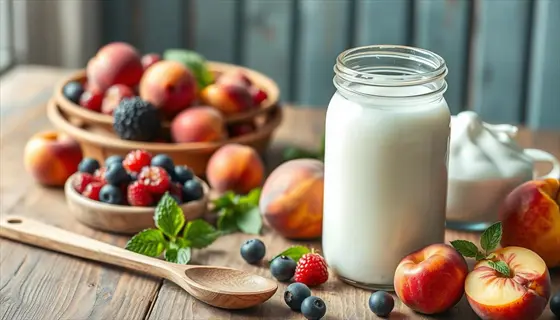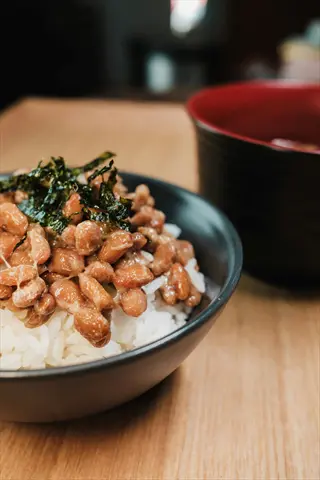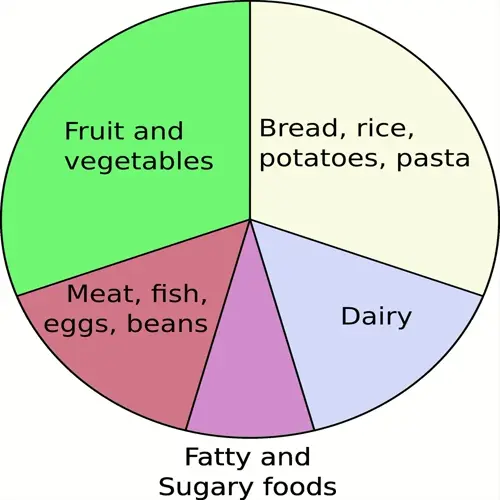10 Essential Probiotic Foods List for Gut Health

Written by
Tran Quang
Reviewed by
Prof. William Dalton, Ph.D.Your personal list of probiotic foods would include yogurt, kefir and kimchi for different gut health benefits.
To help ensure that you receive the live active cultures, eat unpasteurized refrigerated fermented foods.
Prebiotic foods like oats and apples should be eaten with probiotic foods to maximize the effects of both.
Add probiotic foods slowly; a small serving to start, to help your digestive system get used to it.
Tempeh and coconut kefir are not dairy products and would be excellent probiotic options for those on special diets.
Keep all probiotic foods below 40°F to maintain the viability of the culture and shelf life.
Article Navigation
Your path to enhanced gut health begins with understanding probiotics and the importance of food sources that contain them. Probiotics are live bacteria that help balance the natural balance of your digestive system. I always recommend food sources over supplements because they provide a complete range of nutrients. Food provides the enzymes and fiber that increase the efficiency of probiotics.
These foods are powerful allies for three important areas: better digestion, better absorption of nutrients, and better-functioning immune systems. In practice, I have observed that patients who regularly consume probiotic foods experience fewer digestive complaints. Here are our 10 essential probiotic foods with some suggestions for including them in meals. Small daily habits will make a lasting difference for gut health.
Top 10 Probiotic Foods List
The ranks of our list of probiotic foods are based on the variety of acids and their usefulness in the kitchen. Yogurt contains Lactobacillus acidophilus and Bifidobacterium, store below 40°F for maximum effectiveness. Use also with the oatmeal. Kefir has more than 30 strains of bacteria, including Lactobacillus kefiri. Please keep it in the refrigerator and mix with berries. Sauerkraut contains Leuconostoc mesenteroides and is a good source of food in quantity. This too requires careful refrigeration and can be served with slices of apple.
Kimchi contains unique cultures of Lactobacillus kimchii. Refrigerate immediately after opening. Add to rice for balanced meals. Miso contains probiotics of Aspergillus oryzae. Store in the coldest part of the refrigerator. Whisk into soups with seaweed. Tempeh is made with the fungus Rhizopus oligosporus. Keep frozen for long-term storage. Pan fry with garlic cloves.
Kombucha has yeast cultures of Saccharomyces boulardii. Keep bottles refrigerated. Take plain before meals. Fermented pickles have Lactobacillus pentosus. Keep covered with brine in refrigeration. Use for sandwiches. Aged cheeses such as Gouda develop Lactobacillus helveticus. Store in cheese paper. Use for whole-grain crackers. Buttermilk preserves Lactococcus lactis. Refrigerate tightly corked. Use in salad dressings.

Yogurt
- Primary Strains: Features Lactobacillus acidophilus and Bifidobacterium strains clinically shown to support digestive balance by reducing bloating and improving nutrient absorption
- Selection Tip: Always choose products labeled 'live active cultures' while avoiding varieties with added sugars or artificial sweeteners that diminish probiotic benefits
- Nutritional Profile: Excellent source of calcium for bones, high-quality protein, and vitamin D that works well blended into smoothies or layered in parfaits
- Daily Serving: Consume approximately half a cup daily, ideally combined with prebiotic foods like sliced bananas or whole grain oats
- Storage Needs: Maintain refrigeration below 40°F (4°C) and consume within two to three weeks after opening the container
- Special Consideration: Often tolerated by individuals with lactose sensitivity due to fermentation breaking down milk sugars

Kefir
- Strain Diversity: Contains over thirty probiotic strains including unique Lactobacillus kefiri and Saccharomyces species that colonize the gut effectively
- Texture & Use: Noticeably thinner consistency than yogurt makes it ideal for blending into smoothies or drinking directly from a glass
- Lactose Content: Extended fermentation significantly reduces lactose levels making it suitable for many people with dairy sensitivities
- Nutritional Value: Each 8 oz (237 ml) serving delivers high-quality protein, calcium for bones, and essential B vitamins
- Homemade Option: Can be prepared using kefir grains and milk left at room temperature around 68°F (20°C) overnight
- Serving Suggestion: Blend with antioxidant-rich berries and fiber-packed chia seeds for enhanced nutritional benefits

Sauerkraut
- Fermentation Process: Raw cabbage naturally fermented with salt develops beneficial Leuconostoc and Lactobacillus cultures over time
- Selection Guide: Always choose refrigerated, unpasteurized varieties without vinegar or preservatives listed in the ingredients
- Nutrient Content: Each quarter-cup serving (40g/1.4 oz) provides vitamin C for immunity, vitamin K for clotting, and iron
- Culinary Pairing: Complements sausages perfectly, adds tang to sandwiches, or brings flavor to salads with its distinctive profile
- Storage Method: Maintain in airtight container at 32-40°F (0-4°C) for maximum freshness of four to six months
- Health Note: Contains dietary fiber that works synergistically with its natural probiotic microorganisms for digestion

Kimchi
- Key Ingredients: Traditional Korean dish featuring fermented napa cabbage combined with chili, garlic, and ginger spices
- Probiotic Strains: Rich in specific Lactobacillus kimchii and Leuconostoc species developed during natural fermentation
- Serving Ideas: Add to nourishing rice bowls, mix into scrambled eggs, or enjoy as spicy probiotic-packed side dish
- Nutrition Profile: Delivers substantial vitamins A, C, and K plus beneficial capsaicin from included chili peppers
- Storage Tip: Keep fully submerged in brine at 34-38°F (1-3°C) to preserve maximum live culture viability
- Special Characteristic: Contains powerful antioxidants from garlic and ginger with documented anti-inflammatory potential

Miso
- Base Composition: Traditional fermented soybean paste combined with rice or barley and special koji culture
- Umami Quality: Adds deep savory flavor to soups, marinades, and dressings without any dairy components
- Variety Types: Available in white for mild flavor, yellow for moderate, and red for stronger taste
- Usage Tip: Stir into hot liquids below 115°F (46°C) to preserve delicate probiotic microorganisms
- Nutrient Content: Each tablespoon (18g/0.6 oz) provides plant-based protein, manganese, and zinc
- Shelf Life: Lasts six to twelve months refrigerated due to high salt content preventing spoilage

Tempeh
- Origin & Form: Indonesian fermented soybean cake with distinctive firm texture and pleasant nutty flavor notes
- Protein Content: Delivers 15g complete protein per 3 oz (85g) serving making it excellent meat alternative
- Preparation Methods: Steam, bake, or fry for use in vegetable stir-fries, protein tacos, or sandwich fillings
- Vitamin Content: Natural source of vitamin B12 rarely found in plant-based foods due to fermentation
- Storage Guidance: Refrigerate unopened packages; use within five days after opening for best quality
- Special Benefit: Fermentation reduces phytic acid significantly improving mineral absorption capabilities

Kombucha
- Brewing Process: Fermented tea using SCOBY (Symbiotic Culture Of Bacteria and Yeast) culture
- Flavor Range: Available in plain, ginger, berry, or citrus varieties with natural lively carbonation
- Serving Advice: Limit to 8 oz (237 ml) daily and select low-sugar options under 5g per serving
- Caffeine Note: Contains approximately 15mg caffeine per serving similar to decaffeinated tea beverages
- Storage Condition: Always refrigerate at 34-40°F (1-4°C) to maintain maximum probiotic activity
- Safety Tip: Discard bottles showing excessive carbonation or unusual odor indicating over-fermentation

Pickles
- Crucial Distinction: Only salt-brine fermented cucumbers provide probiotics unlike vinegar-pickled versions
- Probiotic Content: Contains Lactobacillus plantarum and other beneficial strains from natural fermentation
- Serving Suggestion: Enjoy whole as healthy snack or chop into salads for satisfying crunchy texture
- Nutrient Profile: Good source of vitamin K for clotting and electrolytes like sodium and potassium
- Brine Value: Liquid contains concentrated probiotics suitable for consuming in small quantities
- Selection Tip: Look for 'naturally fermented' on labels and confirm refrigerated storage requirements

Traditional Buttermilk
- Definition: Liquid remaining after churning butter, distinct from cultured buttermilk sold commercially
- Regional Use: Common in South Asian cuisine including India and Pakistan for drinking and cooking
- Probiotic Strains: Contains Lactococcus lactis from natural fermentation of fresh cream or milk
- Digestive Aid: Helps tenderize meats in marinades and creates light fluffy texture in baked goods
- Serving Temperature: Best consumed chilled at 38-40°F (3-4°C) for most refreshing experience
- Availability Note: Typically found in specialty international markets or prepared at home using cream

Natto
- Japanese Staple: Fermented soybeans with Bacillus subtilis strain creating characteristic sticky texture
- Vitamin K2: Exceptional source of menaquinone supporting bone mineral density and cardiovascular health
- Serving Tradition: Typically mixed with steamed rice, soy sauce, and mustard for breakfast meal
- Acquired Taste: Strong aroma and slimy consistency may require gradual introduction for new users
- Nutrition Facts: Provides 18g protein and 5g fiber per 3.5 oz (100g) serving portion size
- Storage Instruction: Keep refrigerated at 32-39°F (0-4°C) and consume within seven days maximum
Choosing and Storing Probiotic Foods
When selecting the proper probiotic foods, it is essential to understand the concept of pasteurization. Always choose unpasteurized foods that are labeled "live active cultures." All products that are pasteurized have lost their probiotic benefits due to the heat treatment. I recommend freshness in the refrigerated section rather than on the shelf. The labels should clearly indicate the specific strains and the expiration date. The temperature of storage is of utmost importance to maintain their viability. All foods containing probiotics should be stored at a temperature below 40 degrees. They must never be exposed to heat higher than 115 degrees, as this saturation of heat will destroy the beneficial bacteria immediately.
Fermented foods differ in their longevity, and their abilities vary. Yogurt has a life span of 2-3 weeks after being opened. Sauerkraut lasts 4 to 6 months and remains safe if unopened. Miso can be stored for up to a year if kept properly. If you learn the tell-tale signs of spoilage, you will do much to avert waste on fermented products. Spoiled products will exhibit fuzziness or mold growth, have an ammonial odor, or be bulging at the cap. This indicates that the danger of gases has resulted. If cloudy brine is present, fermentation is safe. Trust your senses for general checks on fresh food periods.
Label Reading Essentials
- Critical Terminology: Look for 'live active cultures' or 'unpasteurized' on packaging to ensure viable probiotics
- Ingredient Check: Avoid products with vinegar, preservatives like sodium benzoate, or high sugar content over 8g per serving
- Refrigeration Note: Always choose products requiring refrigeration rather than shelf-stable alternatives
Temperature Control
- Storage Range: Maintain consistent refrigeration between 32-39°F (0-4°C) for optimal culture preservation
- Heat Sensitivity: Never expose probiotic foods to temperatures above 115°F (46°C) during preparation or serving
- Transport Tip: Use insulated bags when purchasing to maintain cold chain integrity
Shelf Life Management
- Yogurt/Kefir: Consume within 2-3 weeks of opening; look for sell-by dates within 30 days (≈4 weeks) of production
- Fermented Vegetables: Sauerkraut/kimchi last 4-6 months unopened; use within 2 weeks after opening
- Miso/Tempeh: Store miso paste 6-12 months; use tempeh within 5 days of opening package
Packaging Considerations
- Container Type: Choose glass jars over plastic to prevent chemical leaching and maintain flavor integrity
- Brine Level: Ensure fermented vegetables remain fully submerged in liquid to prevent mold growth
- Resealing Method: Press air out of bags before sealing homemade ferments to maintain anaerobic conditions
Homemade vs Commercial
- Control Advantage: Homemade versions allow strain customization and avoid pasteurization damage
- Consistency Tip: Commercial products offer standardized probiotic counts between 1-10 billion CFU per serving
- Safety Note: Home ferments require strict sanitation to prevent pathogenic contamination
Visual Quality Indicators
- Fresh Signs: Look for crisp textures in vegetables and consistent coloration without dark spots
- Spoilage Signals: Discard products with fuzzy mold, bulging lids, or sour/ammonia odors immediately
- Carbonation Check: Kombucha should have gentle fizz; excessive bubbling indicates over-fermentation
Incorporating Probiotics into Your Diet
Start your day with breakfast probiotics for lasting energy. Take half a cup of plain yogurt with berries and nuts. Blend kefir into fruit smoothies with bananas for a delicious treat. Add miso to cooled oatmeal. These quantities are ideal for beginners. Coordinate with chia seed or oats. The prebiotics in these foods improve the effect of probiotics.
Enhance lunch and dinner with intelligent probiotic additions. Put one tablespoon of sauerkraut on sandwiches. Stir miso into soups after they are cooked. Use tempeh instead of meat in stir-fries. Use kimchi as a side dish at dinner time. Use with prebiotic foods, such as apples or rice. These foods make for powerful synergistic gut health combinations.
Start by bringing in the probiotics gently. Start with one teaspoon of fermented food. Increase quantity gradually over the two weeks. Pay attention to the degree of bloating, and if it is excessive, reduce it slightly. The goal is to incorporate one to three servings of the probiotic into meals. Try snacking on yogurt parfaits or fermented pickles. It won't be long before the body welcomes these beneficial bacteria.
Breakfast Solutions
- Yogurt Bowls: Combine 1/2 cup plain yogurt with berries, nuts, and 1 tbsp chia seeds
- Kefir Smoothies: Blend 8 oz (237 ml) kefir with banana and spinach for probiotic boost
- Miso Oatmeal: Stir 1 tsp miso into cooked oats after cooling below 115°F (46°C)
Lunch Enhancements
- Sandwich Toppers: Add 1-2 tbsp sauerkraut or kimchi to turkey/veggie sandwiches
- Salad Boosters: Mix pickled vegetables into grain salads for crunch and probiotics
- Soup Finishers: Stir 1 tbsp miso into broth-based soups after cooking
Dinner Applications
- Stir-fry Protein: Use cubed tempeh instead of meat in vegetable stir-fries
- Side Dishes: Serve kimchi or pickled veggies as probiotic-rich accompaniments
- Marinades: Tenderize meats with kefir or buttermilk marinades
Snack Options
- Yogurt Parfaits: Layer yogurt with fruit and granola in small portions
- Pickle Spears: Enjoy 1-2 fermented pickles as crunchy afternoon snack
- Kombucha: Sip 4-6 oz (118-177 ml) as refreshing probiotic beverage
Prebiotic Pairings
- Oats + Yogurt: Combine soluble fiber with probiotics for gut synergy
- Kimchi + Rice: Pair resistant starch with fermented vegetables
- Sauerkraut + Apples: Mix fiber-rich fruit with probiotic cabbage
Gradual Introduction
- Start Small: Begin with 1 tsp/day of fermented foods, increase slowly over 2 weeks
- Monitor Tolerance: Watch for bloating; reduce if discomfort occurs
- Daily Goal: Build to 1-3 probiotic servings distributed across meals
Non-Dairy and Diet-Specific Options
Coconut kefir and tempeh are excellent sources of probiotics in vegan diets. For tempeh, steam before marinating to preserve the cultures. There may be cross-contamination with other allergens if facilities are used for processing soy. To get a taste of the tropics, mix coconut kefir with mango. Additionally, fermented foods such as carrot sticks make wonderful snacks.
Water kefir and kombucha are excellent options for those with gluten intolerance. However, be sure to check the label for possible ingredients containing barley or malt vinegar. It's best to serve kombucha cool to preserve the wonderful live cultures. Try mixing it with a little ginger juice to make a zesty adaptation. Additionally, paleo friends may enjoy trying kimchi and fermented coconut milk. After opening, keep the coconut milk fermented at a temperature below 40 degrees F.
Low FODMAP options include small servings of kimchi. Limit it to one tablespoon as it contains garlic. Test tolerance to tempeh, since fermentation rids irritants. Fresh herbs, such as basil, can be added for flavor, without triggering any allergies. Keto dieters should eat full-fat yogurt and sauerkraut with avocado slices for a creamy texture balance.
Vegan Options
- Tempeh: Fermented soy protein source containing Bifidobacterium strains
- Coconut Kefir: Dairy-free alternative made with coconut water and kefir grains
- Fermented Vegetables: Kimchi and sauerkraut without fish sauce or animal products
Vegetarian Options
- Yogurt: Dairy-based with live cultures (check gelatin-free varieties)
- Aged Cheeses: Cheddar or gouda with 'live cultures' label (avoid rennet-based)
- Miso: Plant-based fermented paste suitable for ovo-lacto vegetarians
Gluten-Free Options
- Kombucha: Naturally gluten-free fermented tea beverage
- Fermented Pickles: Ensure no malt vinegar or barley additives
- Water Kefir: Grain-free probiotic drink made with sugar water and fruit
Paleo-Friendly Options
- Fermented Coconut Milk: Cultured with probiotic strains instead of dairy
- Kimchi: Traditional version without sugar or grains
- Kombucha: Select low-sugar varieties under 3g per serving
Keto-Friendly Options
- Full-Fat Yogurt: Choose plain varieties with under 5g net carbs per serving
- Sauerkraut: Low-carb option with 1g net carbs per 1/2 cup serving
- Fermented Cream: Cultured sour cream with high fat and minimal carbs
Low-FODMAP Options
- Lactose-Free Yogurt: Only effective if labeled 'live active cultures' as pasteurization may kill probiotics
- Small-Serve Kimchi: Limit to 1 tbsp due to garlic content (high-FODMAP ingredient)
- Tempeh: Fermentation reduces oligosaccharides making it more digestible for sensitive individuals
Prebiotics and Probiotics Synergy
Prebiotics are unique fibers that your body cannot break down. They feed the probiotic bacteria in your digestive tract. This combination causes the fermentation of the primary short-chain fatty acids. These fatty acids also help to maintain the gut membrane. They help reduce inflammation throughout the body. Prebiotics are like fertilizer for probiotics.
Combine the living fiber of prebiotics with the living bacteria of probiotics for the best results. Combine 1/2 cup yogurt with 1/3 cup oats. Combine 8 oz. kefir with 1/2 cup berries. Add 1 tablespoon of miso to the cooled soups. Eat 1/4 cup of sauerkraut with slices of apple. This proportion produces perfect harmony for gut health. I have achieved better results when patients follow this approach.
The timing for synergy is important. Consume probiotic and prebiotic food together. This will allow immediate interaction in your system. Aim for daily servings taken together. Use a 2:1 ratio of prebiotics to probiotics. If you have sensitivity in your digestion, start with a small amount and gradually increase to larger doses. Your gut will adjust with frequent use of the above-mentioned products.
Prebiotic Fundamentals
- Definition: Non-digestible plant fibers that serve as fuel for probiotic microorganisms
- Mechanism: Fermented by gut bacteria into short-chain fatty acids like butyrate
- Benefit: Support intestinal lining integrity and reduce inflammation systemically
Synergy Science
- Amplification Effect: Prebiotics significantly enhance probiotic survival and colonization in the colon
- Metabolic Boost: Combined action improves vitamin production (B12, K2) and mineral absorption
- Barrier Support: Butyrate from fermentation strengthens gut barrier function
Top Prebiotic Foods
- Inulin Sources: Jerusalem artichokes, chicory root, dandelion greens, and garlic
- FOS Sources: Bananas, onions, asparagus, and leeks (especially when raw)
- Resistant Starch: Cooked-cooled potatoes, green bananas, and legumes
Optimal Pairing Strategies
- Yogurt + Oats: Combine 1/2 cup (118 ml) yogurt with 1/3 cup (79 ml) oats for soluble fiber synergy
- Kefir + Berries: Blend 8 oz (237 ml) kefir with 1/2 cup (118 ml) berries for polyphenol boost
- Sauerkraut + Apples: Mix 1/4 cup (59 ml) sauerkraut with shredded apple for pectin benefits
Timing Considerations
- Simultaneous Intake: Consume together when possible for immediate interaction in gut
- Frequency Goal: Include at least one paired combination daily for consistent benefits
- Quantity Ratio: Aim for 2:1 prebiotic-to-probiotic food ratio by volume
Special Application Notes
- Sensitive Digestion: Start with small amounts of prebiotics to minimize gas production
- Cooking Tips: Lightly steam fibrous vegetables to increase digestibility while preserving fiber
- Storage Insight: Keep prebiotic foods whole and unprocessed to maintain fiber integrity
5 Common Myths
All yogurts contain probiotics because they are fermented dairy products with active cultures that survive processing.
Many commercial yogurts undergo pasteurization after fermentation, which destroys live probiotic cultures. Only products explicitly labeled 'live active cultures' contain viable probiotics that benefit gut health. Consumers should check labels for specific strain listings and refrigeration requirements to ensure they're getting genuine probiotic benefits, as heat-treated yogurts lack these beneficial microorganisms despite being fermented initially.
Because of the fermentation process, probiotic foods can withstand cooking temperatures.
Most probiotic strain are heat-sensitive, and are rendered ineffective by exposure to temperatures above 115°F (46 C). Cooking, such as baking, boiling or frying, denatures the proteins in these useful microorganisms. You should not cook these types of foods, instead, add fermented foods such as miso, or sauerkraut, cooked, or use them in a raw application, because the only strains with spores such as Bacillus coagulans can survive little exposure to heat.
More of the colony-forming units (CFUs) in a probiotic means better gut health get results for all.
Strain diversity and clinical relevance are far more important than CFU alone. Different strains afford each their own benefits (for example: Lactobacillus rhamnosus GG for prevention of diarrhea), and high CFU products could contain strains that are not effective. The products with the strains studied in clinical studies that apply to you should be the only ones that you resort to, because excessive CFUs without the proper strains can cause digestive distress without any useful benefits.
Probiotic foods lead to weight gain because they have calories like other foods and increase appetite.
There is no scientific evidence implicating probiotics in weight gain. Fermented foods generally have moderate calorie counts and may boost metabolic rates by improving gut barrier function. Certain strains such as Lactobacillus gasseri may assist in weight management by affecting fat absorption and regulating appetite hormones, making probiotics protective rather than damaging in this regard if weight management is the goal.
Dairy foods alone represent consumers' only significant source of natural probiotics from readily available foods.
Many plant based probiotics are available like kimchi, sauerkraut, miso, tempeh, water kefir, etc. These fermented vegetables, soy foods and teas provide different sources of probiotics, such as Bacillus subtilis and Lactobacillus plantarum, without dairy ingredients. These items provide the same benefits for lactose intolerant and vegan individuals and also broaden the availability of probiotics beyond animal products.
Conclusion
Foods rich in probiotics can provide long-lasting benefits for your digestive functioning and immunity. They facilitate the absorption of nutrients your body requires. Your progress toward evolution becomes a lot easier when it aligns with your needs. Consider your own health preferences and limitations. It is this personal aspect of probiotics that assures success. I have seen clients flourish by adapting their probiotics to their needs.
Begin with one simple change today. Start adding yogurt to your breakfast or sauerkraut to your lunch. Build the habit gradually over several weeks. Your gut will adjust more effectively to a gradual introduction. Small, consistent steps yield large results. Think progress instead of perfection. Your digestive tract will reward you.
Sustainable gut health evolves from regular conscious selections. Remember to enjoy the probiotic foods you love. Your future self will appreciate the thoughtfulness. A balanced microbiome is a key to lifelong wellness. Begin your journey of health today with assurance. Your pathway to better health begins now.
External Sources
Frequently Asked Questions
What are the most potent probiotic-rich foods?
The most effective probiotic foods include fermented options with diverse live cultures:
- Unsweetened yogurt and kefir for Lactobacillus strains
- Raw sauerkraut and kimchi for vegetable-based probiotics
- Traditional miso and tempeh for plant-based options
- Unpasteurized kombucha and fermented pickles for beverage sources
Which fruits naturally contain probiotics?
While fruits themselves aren't probiotic, they support probiotic function:
- Bananas provide prebiotics that feed gut bacteria
- Berries offer polyphenols that enhance microbial diversity
- Apples contain pectin that boosts probiotic effectiveness
- Fermented fruits like coconut kefir deliver active cultures
What drinks provide significant probiotic benefits?
Several beverages deliver live cultures for gut health support:
- Kefir: Contains 30+ strains of bacteria and yeast
- Kombucha: Fermented tea with active SCOBY cultures
- Traditional buttermilk: Liquid from churned butter
- Water kefir: Dairy-free option with probiotic grains
How can vegetarians get enough probiotics?
Vegetarians can obtain probiotics from these suitable sources:
- Dairy-based yogurts with live active cultures
- Aged cheeses like cheddar or gouda
- Plant-based ferments including miso and tempeh
- Fermented vegetables without animal products
What's the best time to consume probiotics?
Optimal timing depends on your digestive sensitivity:
- Morning: On empty stomach for better colonization
- With meals: To reduce potential stomach irritation
- Consistently: Daily intake matters more than timing
- Avoid: Right after hot foods/drinks above 115°F
Are there probiotic options for lactose intolerance?
Yes, these lactose-free probiotic foods are well-tolerated:
- Coconut milk kefir and yogurt alternatives
- Fermented soy products like tempeh and miso
- Vegetable-based options including kimchi and pickles
- Kombucha and water kefir beverages
How can I tell if probiotic foods are effective?
Signs of effective probiotic consumption include:
- Improved digestion and reduced bloating
- More regular bowel movement patterns
- Enhanced immune function over time
- Always verify products have 'live active cultures'
What makes a probiotic food more powerful than others?
Potency depends on multiple key factors:
- Strain diversity rather than CFU count alone
- Survival through digestion (e.g., spore-forming strains)
- Refrigeration and proper storage conditions
- Absence of pasteurization after fermentation
Can I get probiotics from common vegetables?
Certain prepared vegetables deliver probiotics:
- Fermented cabbage in sauerkraut and kimchi
- Lacto-fermented cucumbers (pickles in brine)
- Fermented carrots, beets, and radishes
- Important: Must be salt-brined, not vinegar-pickled
How do prebiotics enhance probiotic effectiveness?
Prebiotics boost probiotics through these mechanisms:
- Provide fuel for probiotic growth in the colon
- Increase survival rates during digestion
- Enhance production of beneficial short-chain fatty acids
- Pairing examples: Oats with yogurt or apples with sauerkraut

